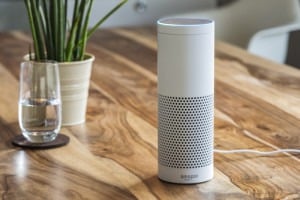
Use of analytics means your digital assistant will know a lot more about you. Expect marketers to use them to develop closer relationships with consumers.
In India, where Amazon’s Alexa assistant is beginning to take off, there was a time when the system’s language processing technology sometimes mistook the Hindi word achcha for “Alexa”—and offered to engage in conversation. Since achcha can mean a wide variety of things depending on the inflection—including “okay,” “oh!” and “listen!”—the glitch could lead to funny interactions between a typical chatty Indian family and its digital assistant.
The achcha phenomenon reminds us of the current limitations of this technology. It’s great at following simple commands but conversation bots can’t yet carry on true human-like conversations.
See also: How AI will transform supply chain management
Before too long, though, conversational assistants like Alexa won’t just be able to carry on a dialogue with you, they’ll actually know who you are — thanks to rapid advances in analytics. When that happens marketers will use them to develop closer, ongoing relationships with every consumer.
Today, using advanced data analytics, businesses can gather a large amount of information about an individual’s lifestyle, likes and dislikes, and use it to design personalized interactions that delight the consumer and drive revenue growth and profitability.
The way brands interact with consumers is changing rapidly because of advances in technology. Smartphones, ubiquitous connectivity through Wi-Fi and 4G, cars brimming with digital technology, and Internet of Things sensors everywhere make it possible for brands and consumers to interact at any time or place.
With their ability to understand simple spoken commands, smart speakers like Alexa and other conversational assistants represent a huge breakthrough because they can be embedded anywhere—in homes, workplaces, schools, public spaces, stores and vehicles. They represent yet another layer of ease and intimacy laid overtop our digital networks. We simply talk, and the Internet listens and responds.
What makes these devices so promising for marketers is their potential to bring one of the most powerful commercial phenomena of our era — the connected consumer — to a whole new level.
Today’s connected consumer not only has all of the power of the Internet at her fingertips, she is firmly in control. That ease of access to information means she’s aware of the products and services she might want to purchase, she can easily comparison shop, and she expects to receive the most competitive pricing and terms of service.
Not only that; she demands a better experience when she interacts with brands, and, in many cases, better means more personalized. She will be loyal only to the brands that truly know her, what she might want to buy, and how she wants to be catered to.
Which brings us back to the enabling technology. Ubiquitous networks and advanced human-to-machine interfaces are essential to addressing the needs of the connected consumer. They’re the digital touchpoints that make e-commerce such a big deal. But deep understanding comes only from gathering and interpreting data from across our digital and physical worlds — connected consumer intelligence.
Think of the information a company gathers about its customers as a multilayered platform for harvesting insights. The bottom layer is the data, stored in repositories capable of handling an increasing variety of data types. The next tier is the rules for organizing and accessing the data. Above that is the analytics layer. And on top sit the applications.
The analytics layer is critical. This is where digital intelligence truly lives: where we learn who the customer really is, how they live and shop for products and services, and how and when they prefer to interact with brands.
Brands now interact in real-time with analytics
A brand no longer just interacts with a given individual at a moment in time — whether in a physical store or online. Through connected consumer intelligence, brands now have the ability to track interactions across time and space, and to use that knowledge to craft customized and timely experiences for each individual.
Joining different sources of consumer intelligence together enables brands to understand individuals across three vectors:
Persona: By gathering and analyzing all of the profile and transaction information a brand has about an individual, it can create a digital persona for them. This persona describes who they are and how they live, work and play. It’s based on facts the brand gathers but extends to characteristics that can be inferred.
Journey: By piecing together information gathered at various consumer touchpoints, a brand can map out how, when and where an individual shops for different kinds of products and services.
Interaction: By observing how an individual shops or researches planned purchases, the brand can develop personalized experiences for them that are more likely to result in purchases and deepen brand loyalty.
A key enabler of a more satisfying relationship between you and a brand is the ability of its technology to learn. Thanks to advances in augmented intelligence, brands can learn who you are, what motivates you, and how you like to be treated.
The more interactions with a brand, the better they understand you. That, in a nutshell, is what makes conversational assistants so enticing for brands.
As these devices become further embedded into the fabric of everyday consumer consumption, it will cause the number of interactions between brands and consumers to skyrocket. With so much more personalized customer data now at their disposal, algorithms will become much more accurate, benefitting brands and consumers alike.
Aided by ongoing conversations between consumers and brands – which will eventually evolve into dialogues — brands will gain a much deeper knowledge of who you are. They will not just be able to understand what you have bought in the past but your intent — which will enable them to figure out what you might want to buy next, and when. Or which new brands – or new experiences — they should introduce you to, and the best time to do so.
As conversational assistants become further embedded in everyday life, new use cases will emerge. Perhaps a smartphone bot will monitor and coach an athlete while he’s training, using smart earbuds for continuous, hands-free communications.
Maybe that scenario won’t come to fruition for a number of years. Then again, technology surprises us with its rapid advances.
When Amazon executives became aware of the achcha glitch, they immediately tweaked their algorithms. Problem solved. This shows how easy it is to make adjustments in products based on software—and how quickly smart speakers will advance to serve, and delight, the connected consumer.






























